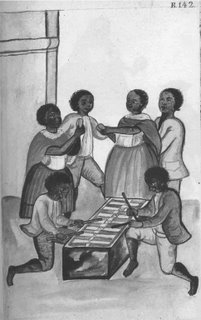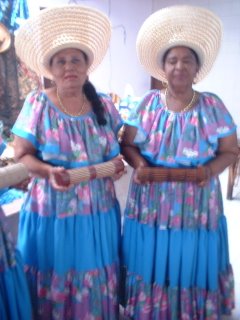 Colombia’s Pacific region is a vast rainforest region, largely cut off from the rest of the country by the western branch of the Andes mountains and stretching along the Pacific coast from southeastern Panama to northwestern Ecuador. Its inhabitants are the descendants of enslaved Africans brought to mine gold in the region. Even before the abolition of slavery in 1851, many escaped to form fugitive slave communities. Others bought their own freedom by mining gold on Sundays.
Colombia’s Pacific region is a vast rainforest region, largely cut off from the rest of the country by the western branch of the Andes mountains and stretching along the Pacific coast from southeastern Panama to northwestern Ecuador. Its inhabitants are the descendants of enslaved Africans brought to mine gold in the region. Even before the abolition of slavery in 1851, many escaped to form fugitive slave communities. Others bought their own freedom by mining gold on Sundays.(Left: The Torres family in their home in Sanson in Guapi, Cauca.)
The descendants of these former slaves live along the banks of the Pacific region’s 240 rivers, practicing the particular culture they have inherited. With the cycles of the tides, they travel the rivers in canoes to fish, farm, hunt, pan for gold, and gather medicinal herbs in different parts of the river basin. They pass long nights reciting and improvising stories, jokes, and rhymed poems, or dancing to the music of the marimba in events called “currulao.” Although they are Catholic, the black river-dwellers celebrate the feast days of the various saints with “arrullos,” bouts of ritual singing and drumming. Funerals, too, are the site of particular ceremonies and musical practices. Along the southern Pacific coast, the focus of this recording, this complex of religious and secular musics exhibits strong West and Central African characteristics, but also shows the influence of the region’s indigenous groups and preserves some elements of 17th century Spanish folk culture and religion. Although these musics are often called “currulao,” there are in fact a number of genres that constitute the musical folklore of the southern Colombian Pacific, including juga, bunde, alabao, canto de boga, and others.
The marimba is an important legacy of the African presence in Latin America. Documentary evidence suggests that marimbas were also played by Afro-Latin Americans in Central America and along the Pacific coast from Colombia’s northern Chocó province as far south as Peru.

(This from Trujillo, Peru in the 1750s. I'll have more to say about this image in a future post.)
Although Central Americans continue to play a marimba borrowed from Africans, the area of the Pacific coast from Buenaventura, Colombia to the northwest corner of Ecuador, is the only place in the Americas where a black marimba tradition has continued in the New World. The Afro-Pacific marimba consists of as many as 24 chonta-wood keys suspended over bamboo resonators and arranged in local tunings outside the notes of the Western scale.
Marimbas are hung from the ceilings of “marimba houses” built alongside the rivers of the Pacific coast. The men of these traditional houses are the marimberos (marimba-players) who preserve and transmit the traditions of the various genres of currulao. The marimba is frequently played by two marimberos, one who plays a pattern in the lower register (bordón) and another who plays the melody and improvises in the upper register (requinta.) Local folklore recounts the legendary musical battles of the marimberos against the devil, who challenges them to virtuosic musical duels where the prize is their very soul.
In a marimba ensemble, there is also a battery of percussion instruments played by men. Two large bass drums called bombos mark the rhythm. The bomberos (bombo-players) play by tapping on the side of the drum’s surface with a wooden stick, and beating on the drum’s skin with a mallet. Each of the two bombos, the smaller bombo arrullador (“singing bombo”) and the larger bombo golpeador (“striking bombo”) has its own role in the music. The bombo arrulador has the more circumscribed part of marking a regular rhythm with few variations, while the bombo golpeador is able to improvise as the bombero varies his strokes in accordance with the intensity of the music.

(Here are Alirio Suárez playing bombo (left) and Isaías "Saxo" Carabalí playing cununo.)
The other male percussion instruments are the cununos, conical wooden drums topped with deerskin that resemble small congas, but are plugged with wood at the bottom to give them a denser and richer sound. The cununo has two basic strokes, a high-pitched slap and a deeper bass stroke. The smaller cununo hembra (female cununo) is charged with marking the beat, while the larger cununo macho (male cununo) rides over and between the beats of the base rhythm to help vary the intensity of the music. At times, male dancers beat the rhythm of the cununo hembra on the floor with their feet in perfect synchronicity with the cununero to display their skill and agility to their partners.
Women also play an essential part in the music of the southern Pacific as cantadoras (traditional singers.) Their gravelly voices, in rich harmony of three or more voices, provide a rhythmic and melodic counterpoint to the instruments. To keep time as they sing, the cantadoras play an instrument called the “guasá,” a bamboo tube filled with tiny seeds that are shaken in precise rhythms to add another rhythm and timbre to the music. While the marimba is central in the currulao, the cantadoras take center stage in the jugas as the marimba follows the vocal melody. In religious music, particularly, the women’s authority as musicians and as preservers and composers of the songs is much respected.

(Juana Angulo (left) and Carlina Andrade, important cantadoras, with guasás.)




No comments:
Post a Comment